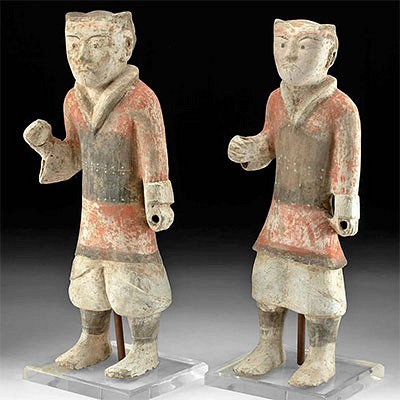Russian Icon - Mother of God (Theotokos)
About Seller
686 S Taylor Ave, Ste 106
Louisville, CO 80027
United States
Selling antiquities, ancient and ethnographic art online since 1993, Artemis Gallery specializes in Classical Antiquities (Egyptian, Greek, Roman, Near Eastern), Asian, Pre-Columbian, African / Tribal / Oceanographic art. Our extensive inventory includes pottery, stone, metal, wood, glass and textil...Read more
Two ways to bid:
- Leave a max absentee bid and the platform will bid on your behalf up to your maximum bid during the live auction.
- Bid live during the auction and your bids will be submitted real-time to the auctioneer.
Bid Increments
| Price | Bid Increment |
|---|---|
| $0 | $25 |
| $300 | $50 |
| $1,000 | $100 |
| $2,000 | $250 |
| $5,000 | $500 |
| $10,000 | $1,000 |
| $20,000 | $2,500 |
| $50,000 | $5,000 |
| $100,000 | $10,000 |
| $200,000 | $20,000 |
About Auction
May 25, 2023
ON-SALE Antiquities, Pre-Columbian, Ethno, More! Artemis Fine Arts info@artemisgallery.com
- Lot Description
Eastern Europe, Union of Soviet Socialist Republic (current-day Russia), ca. second or third quarter of 20th century CE. Painted in egg tempera and gesso on wood, a striking icon depicting the Mother of God (Theotokos) as the Virgin Hodegetria. According to legend, this icon restored the eyesight of two blind men – hence, the name Hodegetria meaning, "She who gives sight" or "shows the way." The Virgin holds the Child in her left hand and points toward him with her right, directing the attention of worshippers. The baby Jesus, dressed in a regal himation, gives the benediction while facing his mother (a gesture of honor), and holds the scroll of the Law in the other. Size: 15.8" W x 19.1" H (40.1 cm x 48.5 cm)
The rolled scroll was an ancient Roman device used when the emperor would designate his ambassadors and governors by giving them a donatus, a scroll indicating that they spoke with his authority. Provincial governors and governmental officials often commissioned statues of themselves with the donatus in hand. This element of Roman iconography found its way into Christian use to express other ideas, as it was essentially neutral in religious values. In this icon, the scroll in Jesus' grasp indicates that Christ has the authority from God the Father to speak on his behalf.
The Hodegetria is an icon that arrived in Constantinople from Jerusalem where the sister-in-law of Emperor Theodosius II found it in the 5th century CE. Hidden from the iconoclasts in a wall at the Hodegon Monastery, it was later carried to the city walls when Constantinople was under siege and became a palladium protecting the capital.
Saint Luke is also known as Luke the Painter, because as the author of the "Gospel of Jesus' Childhood" he is believed to have been the first artist to portray the Theotokos - Mary with the Christ Child image. This understanding is based upon ancient icons from Thebes and Antioch attributed to the evangelist, later transferred to Russia and Constantinople. As the first to paint the Theotokos (Mother of God), Luke's icons include the Hodegetria of the Constantinople Church of the Blachernae, which legend tells us restored the eyesight of two blind men – hence, the name Hodegetria meaning, "She who gives sight" or "shows the way" - as well as the Virgin of Smolensk, a prototype for numerous Marian icons that came to Russia in the 12th century.
Provenance: private New Jersey, USA collection
All items legal to buy/sell under U.S. Statute covering cultural patrimony Code 2600, CHAPTER 14, and are guaranteed to be as described or your money back.
A Certificate of Authenticity will accompany all winning bids.
We ship worldwide and handle all shipping in-house for your convenience.
#174324Condition
Professionally repaired from 2 pieces with overpainting to break lines, chips in tempera, and some other small areas. Some minor chips to tempera and gesso. Small areas of transferred pigment from another painting with which it was stored. Modern back slat on verso. Otherwise, excellent with nice craquelure and rich patina throughout.
- Shipping Info
-
All shipping is handled in-house for your convenience. Your invoice from Artemis Gallery will include shipping calculation instructions. If in doubt, please inquire BEFORE bidding for estimated shipping costs for individual items.
-
- Buyer's Premium



 EUR
EUR CAD
CAD AUD
AUD GBP
GBP MXN
MXN HKD
HKD CNY
CNY MYR
MYR SEK
SEK SGD
SGD CHF
CHF THB
THB













